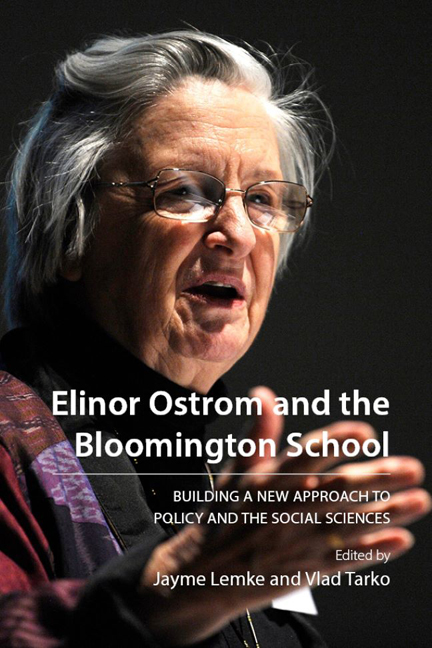Book contents
- Frontmatter
- Contents
- Acknowledgements
- Contributors
- 1 Introduction: the Bloomington school in context
- 2 Public choice theory: reuniting Virginia and Bloomington
- 3 New institutional economics: building from shared foundations
- 4 Elinor Ostrom as behavioral economist
- 5 New economic sociology and the Ostroms: a combined approach
- 6 Foundations of social order: the Ostroms and John Searle
- 7 Environmental policy from a self-governance perspective
- 8 Learning from the socialist calculation debate: is efficiency in public economics possible?
- 9 Public administration from “intellectual crisis” to contemporary “governance theory”
- 10 Rethinking federalism: social order through evolution or design?
- References
- Index
1 - Introduction: the Bloomington school in context
Published online by Cambridge University Press: 21 December 2023
- Frontmatter
- Contents
- Acknowledgements
- Contributors
- 1 Introduction: the Bloomington school in context
- 2 Public choice theory: reuniting Virginia and Bloomington
- 3 New institutional economics: building from shared foundations
- 4 Elinor Ostrom as behavioral economist
- 5 New economic sociology and the Ostroms: a combined approach
- 6 Foundations of social order: the Ostroms and John Searle
- 7 Environmental policy from a self-governance perspective
- 8 Learning from the socialist calculation debate: is efficiency in public economics possible?
- 9 Public administration from “intellectual crisis” to contemporary “governance theory”
- 10 Rethinking federalism: social order through evolution or design?
- References
- Index
Summary
When Elinor Ostrom became the first woman to win the Nobel Prize in economics in 2009, she drew unprecedented attention to the Bloomington school of institutional analysis, a wide-ranging research program in institutional economics and political economy. The well-deserved award was the culmination of over 50 years of inquiry, institution building, and hard work (Tarko 2017). Elinor Ostrom and Vincent Ostrom, the founders and most impactful contributors to the Bloomington school research program, saw themselves as artisans. They both studied diverse forms of institutional design and practiced what they preached by building up research teams and their self-directed Workshop in Political Theory and Policy Analysis at Indiana University in Bloomington. In a 2006 interview, Elinor described their study: “Learning science at a university was very much like learning a craft … We teach our students the best of what we know. Essentially it's a form of artisanship” (Zagorski 2006).
This ongoing and complex research program has developed advanced analytical tools for the study of the production of public goods in metropolitan areas, such as studies of police services and the role of police within communities; problems of federalism, such as how the balance of powers between the multiple overlapping governments that exist around the world can possibly be negotiated; and tragedy of commons challenges in communities of different sizes, from small-scale fishing villages to global-scale climate change. Alongside fellow Nobelists Ronald Coase, Douglass North and Oliver Williamson, Elinor Ostrom's contributions helped form what is now called “new institutional economics”. Further, this research program has long been considered one of the main three schools of public choice economics, alongside the Rochester School, associated with the work of William Riker and Anthony Downs, and the Virginia School, as developed by James M. Buchanan and Gordon Tullock. Throughout the volume, the contributors discuss many other disciplines that have been influenced by the Bloomington school.
The openness and creative potential of the Bloomington approach is on full display in these chapters. Elinor Ostrom and Vincent Ostrom consistently rejected the idea of there being strict divisions within the interdependent, interconnected world of humans and their projects.
- Type
- Chapter
- Information
- Elinor Ostrom and the Bloomington SchoolBuilding a New Approach to Policy and the Social Sciences, pp. 1 - 6Publisher: Agenda PublishingPrint publication year: 2021



